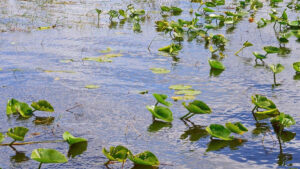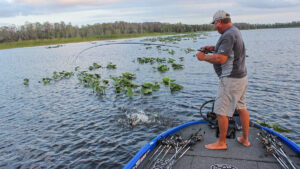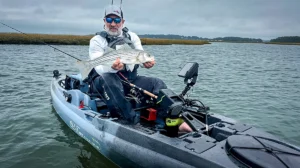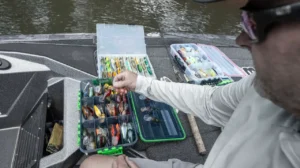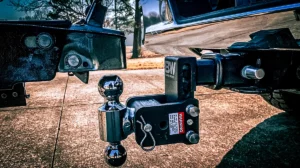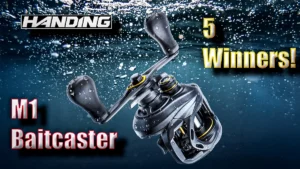Catching bass in lily pads can be intimidating, and trying to find the sweet spots within expansive lily pad fields can be like trying to find a needle in a haystack. Professional angler Terry “Big Show” Scroggins, however, has cracked the code in a big way.
On a recent media trip to Lake Kissimmee, Scroggins left me dumbfounded by his ability to quickly locate bass in these areas. To speed up your learning curve, he shared the three primary elements he considers when searching for productive lily pads.
Clarity is king
The first clue Scroggins uses to discern productive lily pads is water clarity. This is something that can change every day—even throughout the day—but fortunately water clarity reveals itself immediately.
“Water clarity is the very first thing I notice anytime I’m targeting aquatic vegetation,” Scroggins said. “When fishing lily pads, you really want to have clean water. Of course that’s a relative term, but if I can see 10 inches or more, I’m not concerned. It’s when real muddy water blows into a pad field that you probably need to look for a new area. The bass very well still may be there, but it will be nearly impossible to get them to bite.”
Precipitation and wind are the two most common causes of water clarity fluctuation. Rain, sleet, or snow runoff often has mud, silt or other debris flowing with it that can change the clarity on different sections of a fishery overnight. Strong winds can churn up the water, or even blow in dirty and stained surface water depending on the direction from which it’s blowing.
Spacing plays a big role
Another major factor is how scattered or spaced apart the pads are from one another. While Scroggins prefers isolated clumps of pads, he doesn’t focus his efforts on individual lily pads themselves.
“The magic of lily pads isn’t what you see above the water, it’s the roots below,” Scroggins said. “The root system is the structure both baitfish and bass use for cover. I liken lily pads to fishing flooded bushes. I want to fish the biggest, gnarliest bush if I’m flipping shallow cover, not one little twig. For this same reason, I want multiple pads clumped up together to give me a larger, more robust root system to target.”
Scroggins notes bass are most typically set up right in the center of the lily pad roots, in the heaviest cover. Still, he likes to make his first few pitches around the edges of the pads and their roots, as his landing percentage will be higher. After a few presentations around the fringe he’ll flip directly into the heart of the root system.
He also prefers tightly grouped pad fields or clumps of pads because he has found they are more likely to have stable, clean water in their proximity. When faced with rising water scenarios or changing wind directions, this can be hugely important.
Different is good
While Scroggins believes groups of pads to be better than individual pads, he is a big proponent of isolated clumps of lily pads, as shown in the picture above. When he comes across a secluded group of pads, Scroggins spends a lot of time dissecting them.
Years of experience have taught him these clumps are high percentage areas.
“A small clump of pads off by itself is my idea of the juice,” Scroggins said. “The bass have plenty of cover in these clumps, but there are less places for them to hide, so I can fish them quickly and efficiently. These isolated clumps provide excellent habitat for fish and are often home to big, aggressive bass who get territorial over the prime real estate.”
If you’re fishing a lake that only has massive pad fields available, Scroggins recommends paying close attention to any and all irregularities.
“Fish the edge of a massive pad field the same as you’d fish a bank or any other grass line,” Scroggins said. “The points, indentions, turns or any other irregularities will be key spots bass use to spawn and ambush prey on. Depth is often the most overlooked irregularity in these massive pad fields. I mentally note the depth of every bite I get while fishing lily pads. Little depressions and ditches within a pad field can be extremely productive. Even a 6-inch depth change can make a huge difference in the number of bites you get.”
Go-to bait No. 1: Flipping jig
Scroggins’ first choice for lily pads is a simple 1/2-ounce flipping jig. He ties his jig to 65-pound HI SEAS braided line and keeps his color selection between black and blue (stained water) or green pumpkin (clearer water) most of the time.
He also adds a large soft plastic trailer with somewhat aggressive action, like a Strike King Rage Craw.
“With a jig I’m trying to imitate a big bluegill or crawfish darting around the pads,” Scroggins said. “When bass are spawning, the big jig will tick them off to no end and often times they’ll bite in defense of their bed. If bass aren’t spawning and just using the pads as ambush cover, it’s even better. They won’t be likely to pass up the opportunity for a big, easy meal.”
Go-to bait No. 2: Stick worm
His second choice for lily pads is a Texas-rigged stick worm like a Gambler Ace or a Yamamoto Senko. Scroggins prefers to fish the worm weightless if the wind and thickness of the cover allow for it. If faced with steady winds Scroggins adds a pegged 1/4-ounce weight to his rig.
“It is truly hard to beat a stick worm around lily pads, or most aquatic vegetation for that matter,” Scroggins said. “If I’m dealing with frontal conditions, I know for sure the bass are on beds around pads, or I can’t get fish to commit to a jig I won’t hesitate to pick up a Senko. It’s fun to fish and simply gets a lot of bites.”
Go-to bait No. 3: Spinnerbait
Bass aren’t the only fish that likes to spawn in and around lily pads; bluegill and shad also look for romance in the same areas.
“Usually a few weeks after the bass finish spawning, shad go to spawning,” Scroggins said. “Anglers can target the shad spawn around docks, break walls, stumps and really any hard cover; but shad also love to spawn around lily pads and their root systems.”
A reaction lure like a spinnerbait comes through cover extremely well and allows Scroggins to cover water more efficiently in shad spawn scenarios or on low-pressure days when he believes bass are likely roaming.
These tips will save you lots of headache the next time you’re faced with this type of aquatic vegetation. Don’t get overwhelmed when it all looks the same. Instead, think of the above factors and use the cover lily pads provide to your advantage.




